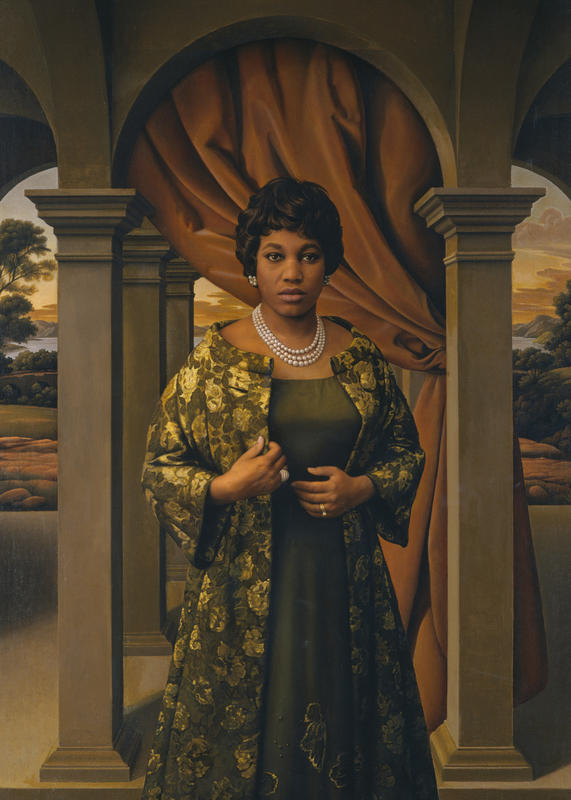More about Leontyne Price

Sr. Contributor
Leontyne Price went from scrubbing a white family’s floors in Jim-Crow Mississippi to headlining the Metropolitan Opera House dripping in jewels.
When Bradley Phillips painted her in 1963, she was skyrocketing up the ladder of a legendary career. She had already played the great opera houses of Europe, and garnered an at least 35-minute standing ovation (Price claimed it was really 42) after her Met debut in 1961. She would soon earn the Presidential Medal of Freedom in 1964, and in 1966, open the brand new Metropolitan Opera House at Lincoln Center in the role of Cleopatra in an opera written especially for her. But before she was, in the words of one ecstatic reviewer, “a goddess performing among us,” she was known to her friends as “just Leontyne;” a working-class Black girl singing in her church choir in Laurel, Mississippi.
The South doesn’t get any deeper than Laurel, Mississippi. It was the hometown of fictional belle Blanche DuBois in Tennessee Williams’ A Streetcar Named Desire. More significantly, it was a headquarters of the Ku Klux Klan, and the site of a 1942 lynching in which a white mob dragged Howard Wash from a jail cell in the middle of the night and hanged him. Just 5 days earlier and 30 miles away from Laurel, two 14-year-old boys, Charlie Lang and Ernest Green, were lynched from a bridge over the Chickasawhay River where they were alleged to have accosted a white girl. Langston Hughes wrote the poem “Bitter River” in response to the atrocity. Price was roughly the same age as Lang and Green at the time, and the murders in and around Laurel that week must have been a grim reminder of the dangers threatening Black people in her circumstances who dared to dream, or even exist.
Even in the face of such horrors, Price found allies in unlikely places. Her aunt worked as a laundress in the mansion of the elite white Chisholm family, where Price often accompanied her to play with the Chisholm children and sometimes worked as a maid. A mutual acquaintance later recalled that the lady of the house, Elizabeth Chisholm, first heard Price singing while scrubbing the floors. Overwhelmed by her talent, Mrs. Chisholm asked Price’s father for permission to sponsor her musical education. There were those who read a “white savior'' dynamic into Price's relationship with the Chisholms, but Price herself hotly contested this characterization. She and the Chisholm girls referred to each other as “sisters,” and Price considered Elizabeth a friend first and sponsor second. For Elizabeth’s part, she rejected the notion that she was Price’s patron, denying that she ever “patronized" Price, only loved her. Price further said that she loved Elizabeth Chisholm more for humbly asking her father’s permission than for any check she ever wrote.
In addition to Elizabeth Chisholm’s sponsorship, Price attributed her success to the sacrifices of her own parents, lumberman James Anthony, and midwife Katherine Baker, and to God. Her parents traded in the family phonograph for the down payment on an upright piano on which Price could practice her music. As the devoutly religious granddaughter of two methodist ministers, she prayed before every performance, telling God, “Dear Jesus, you got me into this, now you get me out.” Even in the darkest days of Jim Crow, there were also fellow Black pioneers to offer inspiration and support. As a child, Price witnessed Marian Anderson singing on a school field trip, and described it as a transformative experience. Price’s Mentor Paul Robeson later held a benefit concert to fund Price’s studies at Julliard. Portraits of Anderson and Robeson are also on view in the National Portrait Gallery, Robeson’s near Price’s in the South Gallery 321 Mezzanine.
Robeson and Price have much else in common. Robeson was the first Black actor since Ira Aldridge to portray Othello in Britain, and the first ever in an integrated production in the US. Othello was typically played by a white actor in blackface, despite being Shakespeare’s only explicitly Black lead role. Price similarly had success in the role of Aida, an enslaved Ethiopian princess. Though one of precious few roles accessible to a Black soprano at the time, the part routinely went to white singers in blackface. Price wryly referred to this problematic trope by calling Aida her “makeup-saver role.” The Metropolitan Opera originally offered Price a debut as Aida, but she held out for the less stereotypical role of Leonora in Il Travatore on the advice of conductor Peter Herman Alder, who proclaimed, “When [Price] makes her debut at the Met, she must do it as a lady, not a slave.”
Alder had previously cast her as Tosca in a TV production for NBC in 1954, opposite a white tenor, marking the first interracial romantic couple depicted on American Television. The broadcast went largely unnoticed at the time, even slipping onto the airwaves in places like Price’s hometown of Laurel, where anti-miscegenation laws still ran strong. However, as awareness of the program rose, so did racist backlash. NBC affiliates across the South boycotted further broadcasts of Price’s performances, echoing an earlier furor in segregationist circles over Robeson’s Othello opposite a white actress.
In this portrait by Bradley Phillips, we see Price in full diva mode, far removed from the girl who set out from Laurel with her first suitcase and only two coats to her name, or the girl banned from TV. By this point she was making six figures, yet too busy with international superstardom to spend them on anything but dresses, hats and suits from the luxury fashion houses of Europe, which her chic attire in this piece reflects. She had acquired a healthy lack of humility befitting someone of her stature, expressed in her famous and often cutting sense of humor. When a male co-star claimed he had moved her to tears with the beauty of his singing, she remarked that only her own voice had the power to move her to tears. When a rival prima donna announced her retirement, Price offered curtly, “Retire from what?” Certainly a person with the Presidential Medal of Freedom, Kennedy Center Honors, the National Medal of the Arts, and more Grammys than any other classical singer in history deserves to drop the mic now and then.
Price is still with us as of the time of writing in 2022, rounding out her first century on this earth. Since her retirement in 1985, she has delighted fans by becoming a movie star at the age of 90, appearing in the 2017 documentary The Opera House which chronicles her inaugural performance at Lincoln Center. She came out of retirement for a charity concert following the September 11 attacks, wowing audiences with her still magnificent voice in an earth-shattering rendition of “America the Beautiful,” a testament to her profound patriotism.
In a nation where Price continued to use the servant’s entrance in her hometown during the same period she was being fitted for couture in Rome, she would be forgiven some natural skepticism regarding her homeland. Nevertheless, she remains unshaken in her belief in both the power of Black excellence and the American dream, saying, “The way I was taught, being black was a plus, always. Being a human being, being in America, and being black, all three were the greatest things that could happen to you. The combination was unbeatable.” This much is sure - no one could beat Leontyne Price.
Sources
- “America’s Prima Donna: Leontyne Price,” Florentine Opera, February 15, 2001, https://www.florentineopera.org/bookclub/americas-prima-donna.
- Awards and Winners. “Leontyne Price.” Accessed September 21, 2022. http://awardsandwinners.com/winner/?name=leontyne-price&mid=/m/025027.
- Bernard, Justin. “A Golden age for Black singers: Marian Anderson, Leontyne Price, Grace Bumbry.” La Scena Musicale, January 28, 2021. https://myscena.org/justin-bernard/a-golden-age-for-black-singers-maria….
- Crain, R. “Three Mississippi Negroes Lynched.” Labor Action 6, no. 43 (October 1942): 1-2. https://www.marxists.org/history/etol/writers/craine/1942/10/lynched.htm.
- Dague, Tyler. “Women with ties to Meadville recall growing up in Mississippi during segregation.” The Meadville Tribune, November 14, 2018. https://www.meadvilletribune.com/news/women-with-ties-to-meadville-reca….
- Driscoll, F. Paul. “Leontyne Price.” Opera News, accessed September 20, 2022. https://www.operanews.com/operanews/issue/article.aspx?id=3671.
- Harvard Library. “Paul Robeson’s Othello: Records from the first major U.S. production with a multi-racial cast.” Accessed September 21, 2022. https://library.harvard.edu/collections/paul-robesons-othello.
- Hautzinger, Daniel. “From the Archive: Leontyne Price.” WTTW: PBS Chicago. August 17, 2020. https://interactive.wttw.com/playlist/2020/08/17/archive-leontyne-price.
- Mississippi Civil Rights Project. “Lynching of Charlie Lang and Ernest Green.” Accessed September 20. 2022, https://mscivilrightsproject.org/clarke/event-clarke/lynching-of-charli….
- “Music: A Voice Like a Banner Flying: Leontyne Price.” Time, March 10, 1961. https://content.time.com/time/subscriber/article/0,33009,826943-8,00.ht….
- National Portrait Gallery. “Leontyne Price.” Accessed September 20, 2022. https://npg.si.edu/object/npg_NPG.91.96.
- National Portrait Gallery. “Portrait Search: NPG, South Gallery 321 Mezzanine.” Accessed September 20, 2022. https://npg.si.edu/portraits/collection-search?edan_fq%5B0%5D=set_name%….
- “Price, Leontyne.” Encyclopedia Britannica. Last modified February 6, 2022. https://www.britannica.com/biography/Leontyne-Price.
- Rosalyn M. Story, And So I Sing (New York: St. Martin’s Press, 1990).
- Salazar, David. “On This Day: 90-Year-Old Leontyne Price’s Wisdom on Race, Art & Success.” Opera Wire, February 10, 2017. https://operawire.com/on-this-day-the-wisdom-of-90-year-old-leontyne-pr….











